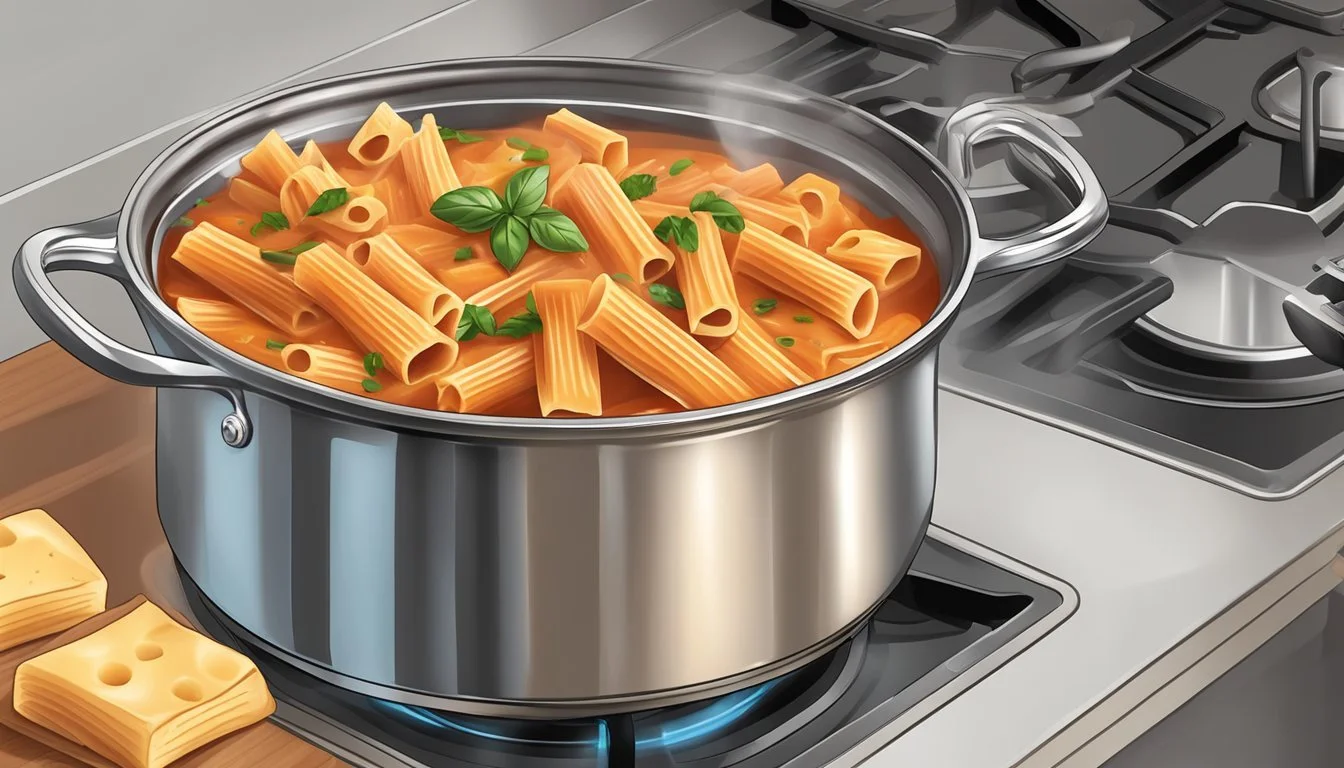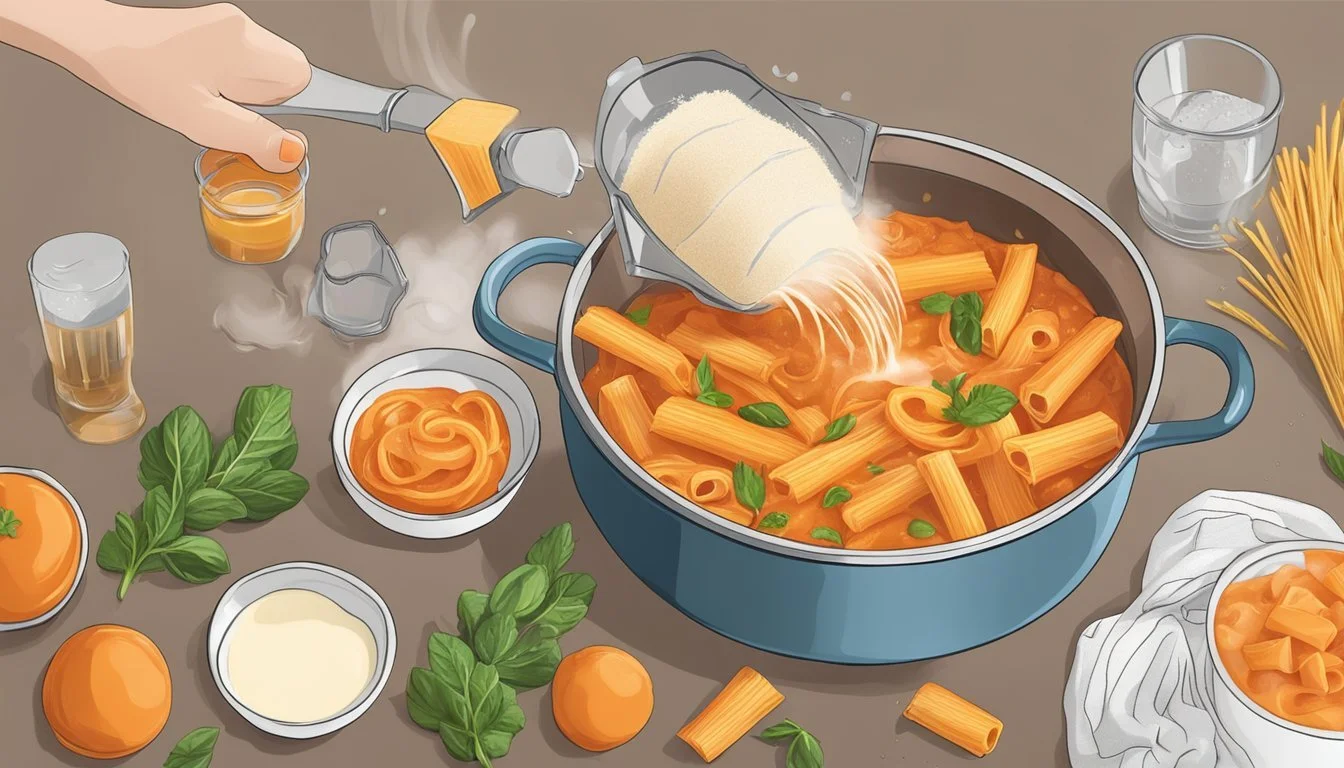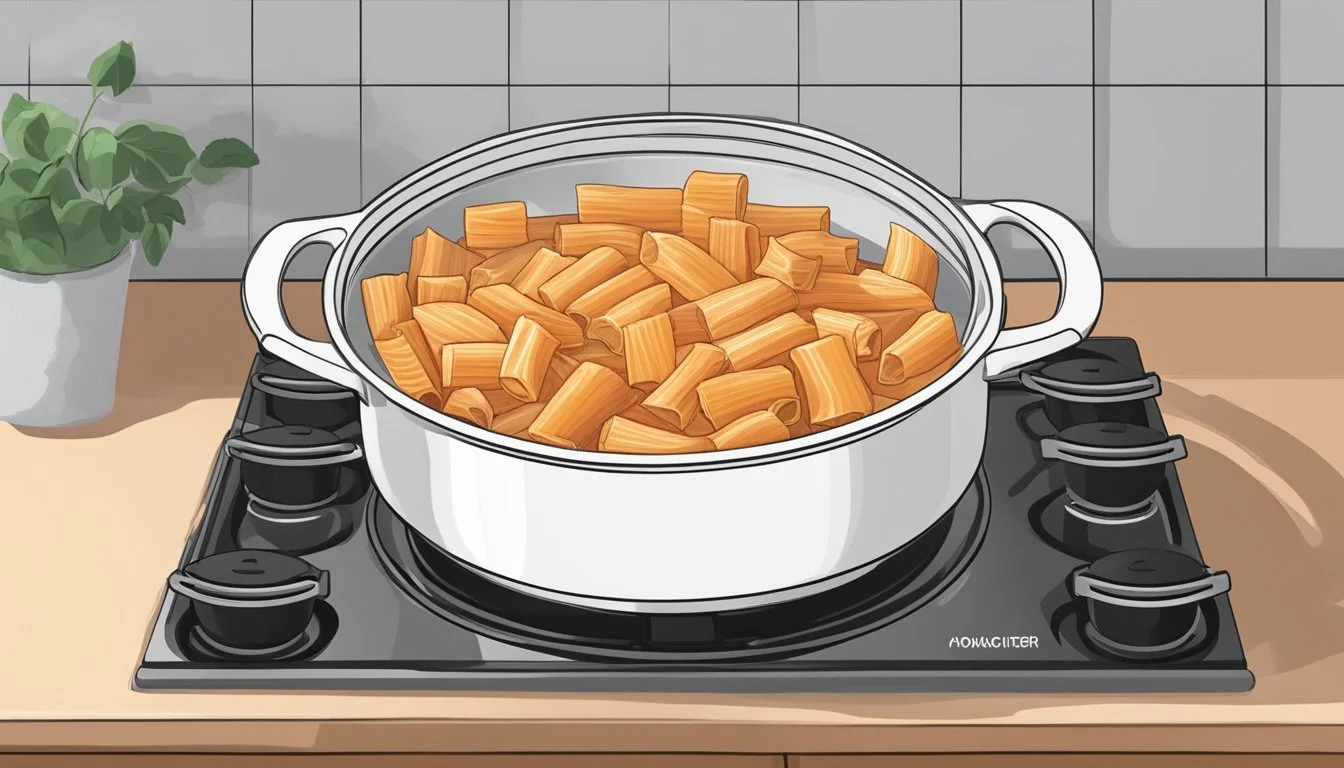Best Way to Reheat Rigatoni with Vodka Sauce
Ensuring Perfect Al Dente Pasta and Creamy Sauce Every Time
Reheating rigatoni with vodka sauce while preserving the pasta's (What wine goes well with pasta?) al dente texture and the sauce's creamy consistency is a culinary challenge often faced when enjoying leftovers. The key is to apply gentle heat and to incorporate a bit of moisture, which helps to revive the dish without compromising its quality. Pasta, particularly rigatoni with its hearty size and ridges, can become soft and lose its bite if not reheated properly. At the same time, vodka sauce, known for its creamy tomato base with a slight kick, can separate or become oily if overheated.
For aficionados of Italian cuisine, the allure of a well-prepared rigatoni with vodka sauce is undeniable, even on the second day. To successfully reheat leftover pasta, the process calls for careful attention to both the rigatoni and the vodka sauce to ensure that every element retains its intended texture and flavor. The goal is to bring the dish to a sufficiently appetizing temperature while maintaining the integrity of each component, crafting a reheated meal that is as satisfying as when it was first served.
Successfully navigating the reheating process allows the enjoyment of rigatoni with vodka sauce beyond its initial presentation. Utilizing methods that do not overly expose the pasta to high heat will ensure the rigatoni remains firm to the bite. Similarly, a controlled approach to warming the vodka sauce will safeguard its smooth and rich character, resulting in a leftover dish that rivals the initial experience of the meal.
Understanding Rigatoni and Vodka Sauce
Rigatoni are substantial, tube-shaped pasta with ridges that are adept at holding sauces. This characteristic makes them an ideal choice for thicker creams and tomato-based sauces. (What wine goes well with tomato-based sauces?) Originating from Italian cuisine, rigatoni's robust texture ensures that it retains an al dente quality, provided it's cooked properly.
Vodka sauce is a creamy, tomato-based sauce enriched with a splash of vodka. The alcohol, when added to the sauce, serves to release flavors in the tomatoes that are otherwise not soluble in water. Despite containing vodka, the sauce does not retain a strong alcoholic flavor, as the alcohol cooks off during preparation, leaving a rich and smooth taste that binds beautifully to the pasta.
An Italian-American creation, pasta with vodka sauce combines the heartiness of tomato sauce with the velvety consistency of cream, elevating it beyond traditional marinara. The vodka, while not imparting strong flavor, does contribute to the sauce's unique texture and a subtle sharpness that complements the sweetness of the tomatoes.
Ingredients of traditional vodka sauce include:
Tomatoes: Usually crushed or in the form of a puree; they form the sauce's base.
Cream: Adds richness and balances the acidity of the tomatoes.
Vodka: Enhances the flavor profile.
Additional seasonings: Often includes garlic, onions, and various herbs.
When Rigatoni and vodka sauce combine, the result is a harmonious dish that is emblematic of the inventive spirit of Italian-American cooking, delivering comfort and sophistication in equal measure.
Pre-reheating Preparation
Before reheating rigatoni with vodka sauce, it's important to ensure the pasta maintains its al dente texture and the sauce keeps its creamy consistency. Adequate preparation is the key to preserving flavor and preventing food safety issues.
Handling Leftover Pasta
When storing leftover rigatoni, one should place it in an airtight container in the fridge to prevent moisture loss and bacterial growth. If the pasta had already been mixed with the sauce, it's important to cool it down rapidly before refrigeration to safeguard against bacteria. In cases where pasta must be stored in the freezer, it should first be cooled in the fridge, then transferred to a freezer-safe container to maintain texture upon thawing.
Selecting the Right Reheating Method
The choice of reheating method depends on the desired outcome for the rigatoni's texture and the vodka sauce's flavor. One can opt for an oven, stove, or microwave. Using an oven can evenly reheat the pasta while preserving the sauce's integrity. The stovetop method is ideal for gently warming the sauce to keep it creamy without overheating. Microwaves are convenient for quick reheating but must be used carefully to avoid uneven heating and pasta texture degradation.
Gathering Necessary Equipment
Reheating requires specific kitchen tools to execute effectively:
Oven: A baking dish, covered with foil to trap moisture.
Stove: A skillet or saucepan, preferably with a lid, provides control over heat distribution.
Microwave: A microwave-safe dish, covered with a microwave-safe lid or damp paper towel, to retain moisture.
In each case, a colander may be needed if the rigatoni and sauce are stored separately, and fresh sauce or water should be at hand to adjust the consistency if necessary.
Reheating on the Stove
When reheating rigatoni with vodka sauce on the stove, maintaining the al dente texture of the pasta and the creaminess of the sauce is paramount. The stove method offers precise control over heat to ensure that the pasta reheats evenly without becoming mushy.
Using a Skillet or Saucepan
To reheat rigatoni with vodka sauce using a skillet or saucepan, one should start by gently warming the pasta over medium heat. It’s advantageous to add a small amount of olive oil or water to the skillet or saucepan to prevent sticking and to preserve moisture. Here's a step-by-step breakdown:
Place skillet or saucepan on the stove.
Add a small amount of olive oil or water.
Gently heat the rigatoni with vodka sauce, stirring occasionally.
Bring to a light simmer, do not overheat to maintain flavor and texture.
Once heated through, promptly remove from heat to serve.
Boiling Water Method
Another stove-based technique involves using boiling water to reheat the pasta separately from the sauce. This method is useful for restoring the pasta's texture without affecting the sauce consistency.
Fill a pot with water and bring to a boil.
Place the rigatoni in a colander and submerge it into the boiling water for 30 seconds to 1 minute, just until heated.
Remove the colander from the pot, allowing the rigatoni to drain.
In a separate skillet or saucepan, gently reheat the vodka sauce, then add the rigatoni, stirring to coat evenly.
Using these methods, one can effectively reheat rigatoni with vodka sauce on the stove, fully preserving texture, flavor, and creaminess.
Reheating in the Oven
Reheating rigatoni with vodka sauce in the oven is an effective method to maintain the pasta's al dente texture while keeping the sauce creamy. The controlled heat allows for even warming without overcooking the pasta.
Using a Baking Dish
To reheat rigatoni with vodka sauce in the oven, one should:
Preheat the oven to 350 degrees Fahrenheit to ensure a gentle and even heat.
Take a baking dish and place the rigatoni with vodka sauce in it, spreading evenly.
If the pasta appears dry, add a splash of water or extra sauce to reintroduce moisture.
Cover the dish with aluminum foil to lock in moisture and prevent the sauce from drying out.
Place the baking dish in the oven and heat for about 10 minutes.
Check the rigatoni periodically to ensure it's heating through and not drying out. If needed, stir the pasta gently to distribute heat and sauce.
By covering the pasta with aluminum foil, the moisture within the baking dish helps to keep the pasta hydrated, thereby preserving its desired texture. Heating in a preheated oven at a calibrated temperature of 350 degrees Fahrenheit ensures that the dish is warmed thoroughly without compromising on the rigatoni's signature bite.
Reheating in the Microwave
When reheating rigatoni with vodka sauce in the microwave, the goal is to preserve the pasta's al dente texture and the sauce's creamy consistency. It's important to use a microwave-safe bowl and add a small amount of water to retain moisture. Here's a step-by-step guide:
Step 1: Place the rigatoni with vodka sauce in a microwave-safe bowl.
Step 2: Sprinkle a few tablespoons of water over the pasta to keep it moist.
Step 3: Cover the bowl with a microwave-safe lid or plastic wrap. This helps to trap steam and prevent the pasta from drying out.
Step 4: Set the microwave to a low heat setting to evenly warm the dish without overheating the sauce, which can lead to separation.
Microwave the pasta:
First interval: Heat for one minute.
Stir: Remove the bowl, stir the pasta gently.
Additional intervals: If needed, continue heating in 30-second intervals, stirring between each, until the desired temperature is reached.
Key Considerations:
Heat distribution: Stirring is crucial for even heat distribution.
Plate Color: Rotate the bowl occasionally, as microwaves may heat food unevenly.
Moisture preservation: Do not skip adding water, as it's vital for maintaining the pasta's moisture.
By following this method, one ensures the rigatoni with vodka sauce warms up without compromising its quality. Microwave reheating is quick, and if done correctly, can yield nearly as satisfying results as the original meal.
Adding Ingredients for Enhanced Flavor
Enhancing the flavor of reheated rigatoni with vodka sauce goes beyond mere temperature adjustment; it involves careful incorporation of select ingredients that complement the dish's existing profile.
Incorporating Fresh Herbs and Spices
One can effectively infuse fresh aromatics into the dish without overpowering the existing flavors. Fresh herbs like basil and parsley may be finely chopped and added to the rigatoni after reheating to rejuvenate the dish with a burst of flavor. The addition of a pinch of red pepper flakes can introduce a subtle heat that amplifies the sauce’s character. For added depth, sautéing finely minced garlic and onions in a small amount of olive oil and stirring them into the sauce brings forward a fragrant and savory dimension.
Basil - Contributes a sweet, peppery layer.
Parsley - Adds a fresh, slightly bitter note.
Red pepper flakes - Provides a gentle heat that enhances overall taste.
Garlic and Onions - Offer a foundational flavor that deepens the dish’s complexity.
Adding Cheese and Cream
Parmigiano-Reggiano, sprinkled atop the pasta right before serving, imparts a salty and nutty accent which melds seamlessly with the creamy vodka sauce. Apart from using it as a garnish, one can also stir in some freshly grated cheese into the sauce to intensify its richness. Should the sauce have thickened too much upon reheating, a splash of heavy cream can help restore its velvety consistency without diluting the potency of the vodka sauce. Both cheese and cream are pivotal in achieving a balance between enhancing flavor and maintaining the creamy texture that is signature to vodka sauces.
Parmigiano-Reggiano - Adds a nutty and sharp counterpoint.
Heavy Cream - Adjusts the sauce’s consistency and enriches its texture.
Finishing Touches and Presentation
Upon reheating rigatoni with vodka sauce to maintain the pasta's al dente texture and the sauce's creaminess, final flourishes can elevate both the visual appeal and taste.
Garnishing for Aesthetic Appeal
To enhance visual appeal, chefs recommend a sprinkle of freshly grated Parmesan cheese and a few fresh basil leaves. The Parmesan adds an additional layer of flavor, while the bright green of the basil offers a pop of color that contrasts beautifully with the creamy pink hue of the vodka sauce.
Garnish:
Fresh basil leaves, whole or chiffonade
Freshly grated Parmesan cheese
These garnishes not only contribute to the aesthetics but also to the overall flavor profile of the dish.
Serving Suggestions
As an Italian-American favorite, penne alla vodka is traditionally served on heated plates to keep the pasta warm. Dollop the reheated rigatoni and sauce in the center of the plate to give it a mound-like appearance, which helps with heat retention. This presentation complements the texture and warmth, ensuring every bite is as intended.
Serving Plates:
Heated plates
Centrally plated rigatoni
The presence of Parmesan as a garnish and a serving option heightens the Italian authenticity of the dish and ties together the ensemble of Italian flavors for an optimal dining experience.
Storing and Preserving Leftovers
To maintain the quality of leftover rigatoni with vodka sauce, proper storage is crucial. The pasta should be allowed to cool to room temperature before being stored to prevent bacterial growth. However, it is important not to leave it out for more than two hours as bacteria thrive at temperatures between 40°F and 140°F.
In the Fridge:
Cooling: Ensure that the rigatoni is at room temperature.
Container: Transfer leftovers to an airtight container.
Storage: Place in the fridge, keeping the temperature below 40°F.
Duration: Leftover pasta with sauce can safely be stored in the fridge for up to three to five days.
In the Freezer:
Freezing: For longer storage, freezing is an option.
Prep: It is advisable to freeze in portion sizes for easier thawing.
Wrap: Use cling film or foil to wrap the container to prevent freezer burn.
Label: Always label with the date to keep track of when it was stored.
Duration: Frozen pasta can last for 1 to 2 months if stored properly. Beyond this, it may suffer from texture changes and loss of flavor.
Note: Thaw frozen pasta in the fridge overnight before reheating, to ensure even warming while keeping the integrity of the sauce and pasta.
Safety and Health Considerations
When reheating rigatoni with vodka sauce, ensuring the safety and health of the dish is paramount. Rigatoni, like any pasta, can harbor bacteria if not stored and reheated properly. The following considerations aim to prevent foodborne illness and maintain the quality of the meal.
Storage:
Pasta with vodka sauce should be stored in the refrigerator within two hours of cooking to minimize the risk of bacterial growth. It should be kept in an airtight container to preserve its quality.
Temperature:
To ensure all bacteria are destroyed, pasta should be reheated to an internal temperature of 165°F (74°C). Using a food thermometer can help confirm the meal has reached a safe temperature.
Reheating:
Heat evenly: Stir the pasta at regular intervals while reheating to distribute heat evenly.
Use a cover: Keep the dish covered to retain moisture and heat.
Avoid over-reheating: Prolonged exposure to heat can cause pasta to become overly soft.
Creaminess:
Maintaining the creaminess of vodka sauce while reheating can be achieved by:
Adding moisture: A splash of water or additional sauce can prevent drying.
Low heat: Gently reheating on a low setting helps to keep the sauce from separating.
Bacteria and Health:
Avoid cross-contamination: Use clean utensils and plates when serving the reheated pasta.
Follow good hygiene: Wash hands before handling food to prevent the introduction of new bacteria.
By adhering strictly to these safety and health guidelines, one can enjoy their rigatoni with vodka sauce with confidence in both its taste and safety.







